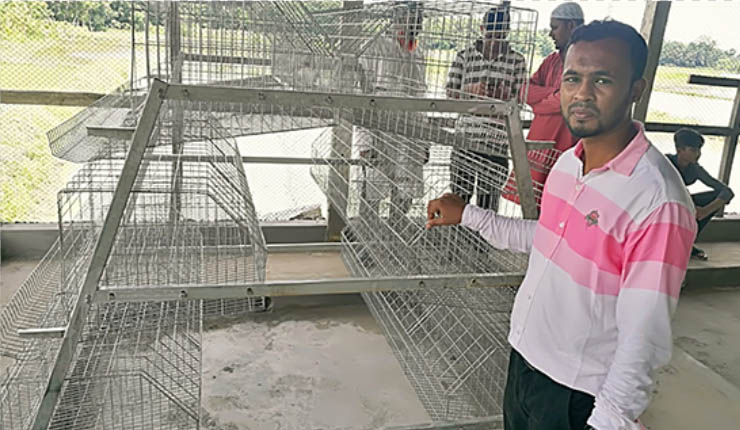cages for layer poultry
Dec . 15, 2024 01:52 Back to list
cages for layer poultry
Cages for Layer Poultry An Overview
Layer poultry farming is a critical component of the global agricultural landscape, providing a significant source of protein through eggs. As the demand for eggs continues to rise, especially in developing nations, efficient farming methods become increasingly essential. One of the prominent systems used in layer poultry farming is the cage system. This article will delve into the various types of cages, their advantages and disadvantages, and the ongoing debates surrounding their use.
Types of Cages
There are primarily two types of cage systems used in layer poultry farming traditional battery cages and enriched cages.
1. Battery Cages This conventional system confines hens in small wire cages, usually housing four to six birds per cage. The design aims to maximize space and reduce costs. However, it has been under criticism for the extreme confinement it imposes on the birds, which limits their natural behaviors such as nesting, perching, and dust bathing.
2. Enriched Cages To address the welfare concerns associated with battery cages, enriched cages—a more humane alternative—have been developed. These cages are larger and equipped with features that allow for more natural behaviors. They include nesting boxes, perches, and scratching areas, thus providing hens with some level of comfort and enrichment while still allowing for intensive production.
Advantages of Caged Systems
Caged systems have several advantages that contribute to their popularity among layer poultry farmers
- Space Efficiency Caged systems allow farmers to keep more hens within a smaller area, leading to higher production per square meter
. This is particularly beneficial in regions where land is expensive or scarce.- Biosecurity Cages can improve biosecurity by reducing the risk of disease spread among birds. The separation between individual birds helps to limit the transmission of pathogens, thus potentially decreasing mortality rates and the need for antibiotics.
- Ease of Management Caged systems facilitate the management of flocks. Farmers can easily monitor the health and productivity of birds, and automated feeding and watering systems can be integrated, reducing labor costs.
Disadvantages and Welfare Concerns
cages for layer poultry

Despite their advantages, caged systems have come under fire for their impact on animal welfare
- Animal Welfare Issues The primary criticism of battery cages is the severe restriction of movement for the hens. Birds in these cages cannot perform basic natural behaviors, leading to stress and potential psychological issues. This confinement can lead to conditions like feather pecking and aggression.
- Public Backlash Growing public awareness and concern for animal welfare have led to increased opposition against the use of battery cages. Consumer demand for more humane products is rising, prompting retailers and suppliers to consider cage-free alternatives.
- Regulatory Changes Many countries and regions are transitioning away from conventional battery cages due to legislative measures aimed at improving animal welfare. The European Union has already adopted bans on battery cages, and similar movements are seen in various parts of the world.
The Transition to Cage-Free Systems
In response to the criticisms of caged systems, many producers are exploring cage-free alternatives. These systems can include barn systems, where birds are kept indoors but are free to roam, or free-range systems, allowing access to outdoor environments.
While cage-free systems promote better animal welfare, they also come with challenges. These include
- Higher Costs Cage-free systems generally require more space and can lead to increased feed and management costs, which can be passed on to consumers.
- Disease Management The increased density of birds in cage-free systems can lead to higher disease risks if not managed correctly. Appropriate vaccination and biosecurity protocols must be established to mitigate these risks.
Conclusion
Cages for layer poultry production will continue to be a heated topic within agricultural discussions. As farmers navigate the fine balance between productivity and animal welfare, the industry appears to be at a crossroads. With shifting consumer preferences and regulatory environments, the future of layer poultry farming may see a transition towards more humane practices. Ultimately, the focus should be on sustainable methods that ensure both the welfare of the hens and the efficiency of egg production. As the demand for eggs continues to grow, it is imperative that the poultry industry adapts to meet these challenges responsibly and ethically.
-
Automatic Feeding Line System - Anping Yize|Poultry Efficiency&Durability
NewsJul.29,2025
-
Automatic Feeding Line System-Anping County Yize Metal Products Co., Ltd.|Durable PP Material&Easy Maintenance
NewsJul.29,2025
-
Automatic Feeding Line System-Pan Feeder Nipple Drinker|Anping County Yize Metal Products Co., Ltd.
NewsJul.29,2025
-
Hot Sale 24 & 18 Door Rabbit Cages - Premium Breeding Solutions
NewsJul.25,2025
-
Automatic Feeding Line System Pan Feeder Nipple Drinker - Anping County Yize Metal Products Co., Ltd.
NewsJul.21,2025
-
Automatic Feeding Line System Pan Feeder Nipple Drinker - Anping County Yize Metal Products Co., Ltd.
NewsJul.21,2025






